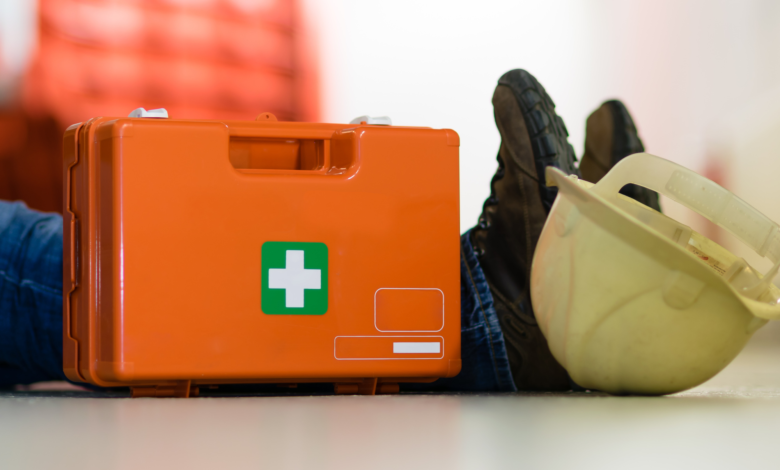Essential First Aid Kits for The Workplace

Do you know Essential First Aid Kits for The Workplace? Everyone deserves to work in a secure setting, and while most employers do their best to minimize injuries, workplace mishaps do unfortunately still happen. First aid kits are a basic need for most businesses, and SafeWork Australia, a statutory government body, has made it necessary for employees to have access to first aid kits at work. We’ll list the crucial supplies that every workplace first aid kit needs in this post.
Read More: Why It’s Important to Practice First Aid: Upbeat First Aid
Determine the workplace requirements
The first aid procedures will range from workplace to work because every workplace is unique. It’s critical that you are aware of and that your first aid expectations are satisfied. In general, your first aid procedures will need to be more extensive the more potential threats there are in your job. A first-aid risk analysis needs to be done. You should focus on the following areas:
- Hazards
- The size
- The location
You must reduce workplace risks, and the first aid measures you take should take into account the dangers, the business’s size, and its location.
Workplace First Aid Essentials

There are several fundamental components that all workplace first aid kits should contain, even if the first aid requirements of a workplace will vary greatly depending on the above-mentioned criteria.
Depending on how employees behave at work, you should determine the size of your first aid supplies in Australia and the number of first aid supplies you’ll need. Make sure your first aid supplies are suited to your workplace and the number of potential users. Small first aid kits won’t be adequate for a large group of people, and they’re also unsafe. You’ll need to update the supplies frequently. To assist in the treatment of occupational injuries, a first aid pack must include essential supplies like:
- Burns
- Cuts and wounds
- Muscle sprains, and strains
- Fractured or broken bones
- Eye injuries
- Removing splinters and debris from the skin
- Foreign objects such as dirt in the eyes
- Control bleeding
- Abrasions and punctures
- Shock
- Cleaning and covering wounds, cuts, abrasions, and punctures
- Spider and snake bites
All staff members should have quick access to and recognition of your first kit. The locations of the first kits should be known to everyone in the company. The equipment should be clearly labelled with the words “FIRST AID” and a huge white cross on a red or green backdrop. To protect the contents of your kit from external harm like dirt and dampness, it must be of good quality. Your first aid kits for the workplace should, at the at least, have the items listed below, according to SafeWork Australia:
- An instruction booklet, a notepad and a pen
- Saline solution
- Disposable gloves
- Hand sanitizer
- Adhesive plasters
- Medical grade tweezers
- Single-use splinter removers
- Gauze in several sizes
- Bandages, both elastic and no-stretch in various sizes and styles
- Dressing pads
- Antiseptic cream/lotion
- Hypoallergic adhesive tape
- Eye pads
- CPR face shield
- Safety pins
- Rescue blanket
- SAM splint
- Instant cold and heat packs
- Antiseptic wipes
The first aid supplies in a workplace should be adapted to the higher risk that particular injuries provide. People who operate with abrasive chemicals, for instance, should have extra gear like an eye wash station, extra eye pads, etc.
You could visit the SafeWork website for more information if you are unsure of what first aid procedures your workplace requires.
No of the time, day, or location of the shift, you must always have access to first aid training and first aid professionals in addition to a first aid kit.
Read More: Can Drugs for ED Aid in Alzheimer’s Prevention?
Trained first aiders in the workplace
The more individuals who know how to use a first aid kit in the office, the better. Having one is usually a good idea. Some sectors, but not all, need first-aid training as a prerequisite for the position. Employees of the company or other qualified people can serve as first responders in the workplace.
- A nationally recognized certificate of attainment in first aid training
- They should complete regular training to update their skills and knowledge in first aid and to ensure their certificate is current and up to date
Additional training may be required for first aiders who:
- Work in an isolated or remote location
- There are psychological risks in the workplace
- Employees have existing medical conditions
- Children are in the workplace
How many first responders is required at your workplace?
SafeWork Australia stipulates that:
- Low-risk workplaces should have one first aider for every 50 employees
- High-risk workplaces should have one first aider for every 25 workers
- Remote high-risk workplaces should have one first aider for every 10 workers
First aid personnel should be simple to locate and identify in the workplace. You might do this by having the first responder wear a high-visibility vest or by having a contact number displayed.
A defibrillator is an additional useful but optional piece of first aid gear that all business owners should think about. If CPR is not started during the first few minutes of cardiac arrest, the patient may not survive. A defibrillator on location can prevent a fatality. Employees would benefit greatly from knowing CPR in addition to first aid in the workplace. Learning how to operate a defibrillator effectively is part of CPR training. If you decide to take both first aid and CPR classes, you can finish them both in a single day.
Does your place of business have what it takes to provide effective first aid?
Knowing what is required of your workplace depending on the size, location, the number of employees, and the risk is vital since the contents of a first aid kit in a high-risk setting like a mine would differ significantly from a first aid kit in a low-risk setting like an office.
Visit the First Aid Shop for all your office supplies and kits! Hansaplast India offers a range of braces, first aid kits, and wound healing plasters that may properly treat you and your staff members in the event of an incident. First aid administered promptly and correctly can enhance health outcomes and, in more catastrophic situations, possibly save lives.







